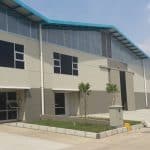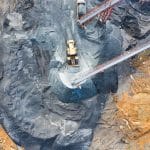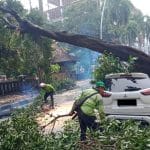Liga Asuransi – Dear risk takers, how are you? I hope your business is doing well.
As a senior insurance broker, as always, this site will keep focusing on the discussion about risk management and insurance. This time we will explore the main risk that threatens the hydropower industry which is a landslide. Because the topic of this discussion area is complex and details, the discussion will be in 3 articles, this is the 2nd article so please ensure you read all 3 articles so can you get the whole picture of the messages.
Mitigasi Risiko Longsor Di PLTA Indonesia: Strategi Dan Solusi – Bagian 1
If you are interested in this article, please share it with your friends so they can understand as much as you do.
Overall, hydropower in Indonesia’s energy mix aligns with the country’s goals of achieving sustainable, reliable, and environmentally friendly energy generation while promoting economic growth and energy security.
THE IMPORTANCE OF CHOOSING SUITABLE LOCATIONS
Choosing suitable locations with low landslide susceptibility is of paramount importance in the planning and construction of infrastructure, particularly in the case of hydropower plants. Here are several key reasons why selecting such locations is crucial:
Safety:
The primary concern is the safety of personnel, the public, and the environment. Low landslide susceptibility areas reduce the risk of accidents, injuries, and fatalities associated with landslides.
Asset Protection:
A low-susceptibility location helps protect the substantial financial investments made in building and maintaining hydropower infrastructure. This reduces the potential for infrastructure damage and the need for costly repairs.
Operational Continuity:
Hydropower plants are designed for continuous operation. Low susceptibility locations minimize the risk of unexpected shutdowns due to landslides, ensuring a stable power supply.
Environmental Preservation:
Siting hydropower plants in low-susceptibility areas reduces the risk of environmental damage, such as sedimentation of rivers and harm to aquatic ecosystems. It also helps protect the natural landscape and habitats.
Reduction in Economic Loss:
Low susceptibility areas result in reduced economic losses stemming from damage to infrastructure, power generation interruptions, and the cost of emergency response and recovery.
Resource Efficiency:
Selecting low-susceptibility locations optimizes resource allocation by minimizing the need for landslide mitigation measures, ongoing monitoring, and extensive maintenance.
Regulatory Compliance:
Many countries have regulations and standards in place to govern the safe construction and operation of critical infrastructure like hydropower plants. Compliance with these regulations is more achievable in low-susceptibility areas.
Public Confidence:
Choosing safe locations builds trust and confidence among the public and local communities. This support is essential for the smooth operation of hydropower plants and the successful implementation of future projects.
Long-Term Viability:
To ensure the long-term viability of hydropower facilities, low-susceptibility areas should be prioritized. This includes considering factors like climate change, sedimentation, and geological stability.
Cost-Efficiency: Low susceptibility areas typically result in lower insurance premiums and less expenditure on landslide mitigation, which contributes to the cost-efficiency of the project.
Community Well-Being:
Siting hydropower plants in low-susceptibility areas safeguard the well-being of nearby communities by reducing the risk of damage to homes, infrastructure, and livelihoods.
Sustainability:
Choosing low-susceptibility locations aligns with sustainability goals by minimizing the negative environmental and social impacts of hydropower development.
In conclusion, the choice of location is fundamental to the overall success and sustainability of hydropower plants. Low landslide susceptibility areas offer a range of benefits, including safety, asset protection, environmental preservation, and long-term viability. Careful site selection is a proactive and prudent approach to minimizing risks and ensuring the reliability of hydropower generation.
STRUCTURAL AND GEOTHERMAL ENGINEERING MEASURES
Structural and geotechnical engineering measures, such as retaining walls, slope stabilization, and drainage systems, are crucial for mitigating landslide risks in areas with susceptibility to slope failures. These measures aim to enhance the stability of slopes and minimize the potential for landslides. Here’s a discussion of these measures:
Retaining Walls:
- Purpose: Retaining walls are vertical or near-vertical structures designed to hold back soil and prevent downslope movement. They are used to reinforce slopes and stabilize them, particularly in areas with steep terrain.
- Types: There are different types of retaining walls, including gravity walls (relying on their weight), cantilever walls (leveraging structural design), and reinforced soil walls (using geosynthetic reinforcements).
- Materials: Retaining walls can be constructed from various materials, such as concrete, gabions, timber, or segmental blocks, depending on the project’s specific requirements and environmental considerations.
- Design: Engineers conduct detailed design and analysis to determine the appropriate height, dimensions, and reinforcements needed for the retaining wall to withstand the anticipated forces and pressures.
Slope Stabilization:
- Purpose: Slope stabilization techniques are employed to enhance the stability of natural or man-made slopes by mitigating the factors that contribute to landslides. These measures aim to increase the frictional resistance, cohesion, and overall strength of the slope.
- Methods: Several methods can be used, such as planting vegetation on slopes, installing rock bolts or soil nails, applying shotcrete or mesh, and using geotextiles or geogrids to reinforce the soil.
- Analysis: A detailed geotechnical analysis is performed to assess the specific conditions of the slope and determine the most appropriate stabilization methods and materials.
Drainage Systems:
- Purpose: Proper drainage is essential for preventing excess water from infiltrating the soil and increasing its weight, which can lead to slope instability. Effective drainage systems channel water away from critical areas.
- Components: Drainage systems may include surface drainage (ditches, swales, and channels), subsurface drainage (drainpipes or weep holes), and retention ponds to manage and redirect excess water.
- Slope Drainage: Engineers design slope-specific drainage systems that consider the topography, soil type, and anticipated rainfall patterns to ensure efficient water removal.
- Maintenance: Regular maintenance of drainage systems is crucial to keep them functioning effectively and preventing erosion, sediment buildup, and clogging.
Monitoring and Early Warning Systems:
Instrumentation: The installation of monitoring equipment, such as inclinometers, piezometers, and geotechnical sensors, helps continuously assess slope stability and ground movement.
Data Analysis: Collected data is analyzed to detect any anomalies or changes in slope conditions. Early warning systems can be triggered to alert relevant authorities and communities of potential landslide risks.
These structural and geotechnical engineering measures work in tandem to reduce the likelihood of landslides in vulnerable areas. They are often integrated into comprehensive landslide risk management plans, which consider site-specific factors and the geological, environmental, and topographical conditions of the project location. Proper design, construction, and maintenance of these measures are essential for the long-term stability and safety of infrastructure in landslide-prone regions.
MONITORING EQUIPMENT, SENSORS AND PREDICTIVE TECHNOLOGIES
Monitoring equipment, sensors, and predictive technologies play a crucial role in providing timely warnings and enhancing the safety and reliability of infrastructure in landslide-prone areas. Here’s how they contribute to early warning systems:
Continuous Data Collection:
Monitoring equipment and sensors continuously collect data on various parameters, including ground movement, groundwater levels, soil moisture, and weather conditions. This real-time data provides insights into the stability of slopes and the potential for landslides.
Anomaly Detection:
Predictive technologies analyze the collected data to detect anomalies or deviations from expected conditions. Sudden changes in ground movement, increased groundwater levels, or other unusual patterns can serve as early indicators of potential landslide risks.
Threshold Alerts:
Early warning systems are programmed with predefined thresholds or trigger levels. When monitored parameters exceed these thresholds, the system generates alerts or warnings, signaling the need for immediate attention or action.
Automated Notifications:
Early warning systems are often automated and can send notifications to relevant authorities, operators, and communities through various communication channels, including text messages, emails, sirens, or public address systems.
Data Integration:
Monitoring equipment and sensors are integrated with geographic information systems (GIS) and modeling software, allowing for the visualization of real-time data on maps and the creation of predictive models.
Modeling and Predictive Technologies:
Advanced predictive technologies, such as numerical modeling and machine learning algorithms, use historical data and real-time inputs to forecast landslide risks. These models can simulate potential landslide scenarios and estimate the likely impact.
Local and Remote Monitoring:
Monitoring equipment can be distributed across the site, including the slopes, infrastructure, and drainage systems. This enables a comprehensive assessment of the area. Remote monitoring also allows data to be collected from inaccessible or hazardous locations.
Early Warning to Communities:
In addition to notifying authorities and operators, early warning systems can also provide alerts to nearby communities at risk, giving residents time to evacuate or take necessary precautions.
Maintenance and Calibration:
Regular maintenance, calibration, and quality control of monitoring equipment are essential to ensure the accuracy and reliability of the data. Malfunctioning sensors or inaccurate readings can lead to false alarms or missed warnings.
Response Planning:
Data from monitoring systems inform response plans. When alerts are triggered, authorities and emergency responders can follow predetermined protocols to manage risks and protect public safety.
Public Awareness and Education:
Early warning systems may also include public awareness and education campaigns to inform local communities about the risks and the actions to take when they receive warnings.
The integration of monitoring equipment, sensors, and predictive technologies into early warning systems provides decision-makers, operators, and communities with valuable information to respond effectively to landslide risks. These technologies help prevent casualties, protect infrastructure, and reduce the economic and environmental impact of landslides in susceptible areas.
MAINTAINING THE RIGHT TYPE OF VEGETATION
Maintaining the right type of vegetation can significantly enhance slope stability by providing a natural and effective means of erosion control and soil reinforcement. Here’s how vegetation contributes to slope stability:
Root Reinforcement:
The root systems of vegetation, particularly deep-rooted plants and trees, penetrate the soil and create a network of roots that bind soil particles together. This reinforces the cohesion of the soil and increases its resistance to erosion and downslope movement. The tensile strength of roots can anchor the soil and reduce the risk of shallow landslides.
Water Absorption:
Vegetation helps regulate soil moisture by absorbing water through its roots and releasing it through transpiration. This reduces the potential for soil saturation and helps maintain optimal moisture levels for slope stability. Excess water in the soil can increase its weight and reduce cohesion, making it more prone to landslides.
Erosion Control:
The canopy and ground cover provided by vegetation act as a protective layer against the impact of raindrops. This minimizes soil detachment and erosion caused by heavy rainfall, preventing the gradual loss of soil from the slope.
Protection from Surface Runoff:
The root systems of vegetation reduce surface runoff by promoting water infiltration. This minimizes the flow of water over the slope, which can erode the soil and lead to slope instability.
Debris Trapping:
In areas susceptible to rockfall or debris flow, vegetation can act as a barrier, trapping falling debris and stabilizing the slope. The presence of vegetation can reduce the speed and impact of moving debris, preventing it from causing further damage.
Improved Soil Structure:
The decaying organic matter from plants contributes to the development of stable soil structures. This organic material enhances soil aggregation and improves soil structure, reducing the likelihood of erosion.
Biodiversity:
A diverse range of plant species with different root structures and growth habits can further enhance slope stability. Different types of vegetation can work together to strengthen the soil and maximize its resistance to erosion.
Aesthetic and Ecological Benefits:
Maintaining the right type of vegetation can also offer aesthetic and ecological benefits. It preserves natural landscapes, supports wildlife habitat, and contributes to the overall health of the ecosystem.
Choosing the appropriate type of vegetation for slope stabilization depends on various factors, including climate, soil type, site conditions, and the specific goals of the project. Native vegetation is often preferred as it is adapted to local conditions and requires less maintenance. Vegetation management involves planting, regular maintenance (such as pruning and weeding), and periodic assessments to ensure that the plant cover remains effective in enhancing slope stability.
WHY DO YOU NEED EXPERIENCED INSURANCE BROKER TO ARRANGE INSURANCE FOR THE HYDROPOWER PLANT?
Engaging an experienced insurance broker is highly beneficial when arranging insurance for a hydropower plant due to the complex and specialized nature of the insurance process in the energy and infrastructure sectors. Here are several reasons why an experienced insurance broker is essential:
Industry Expertise:
Experienced insurance brokers have in-depth knowledge of the energy and infrastructure sectors, including hydropower. They understand the unique risks associated with such projects and are familiar with industry-specific insurance products and coverage needs.
Risk Assessment:
Insurance brokers can assess the specific risks of a hydropower plant comprehensively. They understand the complexities of landslide risks, operational disruptions, equipment breakdown, and other potential issues. This expertise helps in securing adequate coverage.
Access to Specialized Markets:
Experienced brokers have access to a wide network of insurance providers, including those who specialize in energy and infrastructure. This allows them to source competitive quotes and tailor insurance solutions to the project’s needs.
Customized Coverage:
Insurance brokers work closely with clients to develop customized insurance packages that address the unique risks of a hydropower plant. They ensure that the coverage aligns with the project’s size, location, and specific risk factors.
Cost-Effective Solutions:
Brokers can negotiate on behalf of the client to obtain favorable terms and pricing. They help clients strike a balance between cost-effective coverage and comprehensive protection.
Claims Assistance:
In the unfortunate event of a claim, experienced brokers can assist in the claims process. They advocate on behalf of the client to ensure that claims are handled efficiently and fairly.
Risk Management:
Brokers often provide risk management advice to clients, helping them implement preventive measures that can reduce the likelihood of insurance claims and lower overall insurance costs.
Regulatory Compliance: Insurance brokers stay up to date with local and international regulations related to insurance in the energy sector. This ensures that clients remain compliant with legal requirements.
Savings in Time and Resources:
Engaging a broker saves time and resources that would otherwise be spent researching insurance options, negotiating with insurers, and managing the administrative aspects of insurance.
Long-Term Relationships:
Experienced brokers develop long-term relationships with their clients, working with them on multiple projects. This continuity ensures that the insurance coverage evolves to meet changing needs.
Peace of Mind:
With an experienced broker handling insurance matters, clients have peace of mind knowing that they have expert guidance and support in managing their risk exposure.
In summary, an experienced insurance broker plays a pivotal role in securing the right insurance coverage for a hydropower plant. They provide industry-specific knowledge, access to specialized markets, customized solutions, and claims support. This expertise ultimately helps protect the investment and ensure the long-term success of the project.
One of the leading insurance brokers in Indonesia focusing on Hydropower plants is L&G Insurance Broker.
For your insurance needs in Indonesia, call L&G Insurance Broker now!
—
LOOKING FOR INSURANCE PRODUCTS? DON’T WASTE YOUR TIME AND CONTACT US RIGHT NOW
L&G HOTLINE 24 HOURS: 0811-8507-773 (CALL – WHATSAPP – SMS)
website: lngrisk.co.id
E-mail: customer.support@lngrisk.co.id
—















